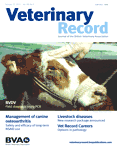Veterinary Record
Vet Record is a peer-reviewed medical journal in the field of veterinary medicine. It is mainly distributed to members of the British Veterinary Association as part of their membership. It was established in 1888.[1]
 | |
| Discipline | Veterinary medicine |
|---|---|
| Language | English |
| Edited by | Adele Waters |
| Publication details | |
| History | 1888–present |
| Publisher | |
| Frequency | 50/year |
| 2.050 (2017) | |
| Standard abbreviations | |
| ISO 4 | Vet. Rec. |
| Indexing | |
| CODEN | VETRAX |
| ISSN | 0042-4900 |
| LCCN | sv89073252 |
| OCLC no. | 1769072 |
| Links | |
History
The journal was established in July 1888 by William Hunting, who is said to have started the journal with loans of £50 from another London veterinary surgeon, T. A. Dollar, which he never repaid, and £20 from Dollar's son, J.A W. Dollar. Although The Veterinarian (1828) and The Veterinary Journal (1844) were well established and covered some of the same ground as Hunting's new journal, the fact that Veterinary Record was published every week and carried verbatim reports of council and local association meetings gave it an immediacy that the other publications could not match.[2]
Since July 2009, VetRecord has been published by the BMJ Group on behalf of the British Veterinary Association.[3]
Abstracting and indexing
The journal is abstracted and indexed by MEDLINE, ISI Current Contents (Web of Science), EMBASE and Sociedad Iberoamericana de Informacion Cientifica (SIIC).[4] According to the Journal Citation Reports, the journal has a 2017 impact factor of 2.050.[5]
Most cited articles
According to the Web of Science, the following three articles have been cited most often:[6]
- Benestad SL, Sarradin P, Thu B, Schönheit J, Tranulis MA, Bratberg B (August 2003). "Cases of scrapie with unusual features in Norway and designation of a new type, Nor98". Veterinary Record. 153 (7): 202–8. doi:10.1136/vr.153.7.202. PMID 12956297. S2CID 19788587.
- Gibbens JC, Sharpe CE, Wilesmith JW, Mansley LM, Michalopoulou E, Ryan JB, Hudson M (December 2001). "Descriptive epidemiology of the 2001 foot-and-mouth disease epidemic in Great Britain: the first five months". Veterinary Record. 149 (24): 729–43. doi:10.1136/vr.149.24.729. PMID 11808655. S2CID 43718744.
- Whay HR, Main DC, Green LE, Webster AJ (August 2003). "Assessment of the welfare of dairy cattle using animal-based measurements: direct observations and investigation of farm records". Veterinary Record. 153 (7): 197–202. doi:10.1136/vr.153.7.197. PMID 12956296. S2CID 40615566.
Brunus edwardii joke
The April Fools' Day 1972 issue included a paper on the diseases of Brunus edwardii: a description of lost limbs and thinning hair suffered by an animal whose Latin name means "brown" and "Edward". The paper was accompanied by sketches of a teddy bear resembling Winnie the Pooh.[7][8]
Popular culture
The journal is mentioned and appears regularly in the BBC series All Creatures Great and Small. In the episode "The Call of the Wild", the character based on James Herriot's assistant Brian Nettleton, has an article published in the Record, much to the chagrin of Herriot's partner Donald Sinclair.
References
- "About The Veterinary Record". The Veterinary Record. Retrieved 2010-02-23.
- Edward Boden. "Practice and Politics: the British Veterinary Association 1881 – 1919" (PDF). British Veterinary Association. Retrieved 2010-02-23.
- "New from the BMJ Group" (PDF). BMJ Group. Retrieved 2010-02-23.
- "Animal Health Library - Veterinary Journals Indexed in MEDLINE". Retrieved 2010-02-23.
- "Veterinary Record". 2017 Journal Citation Reports. Web of Science (Science ed.). Clarivate Analytics. 2018.
- "Web of Science". Retrieved 2010-02-23.
- "The April fool's day database". Brunus edwardii (1972). 1972. Retrieved 27 March 2010.
- Blackmore, DK; DG Owen; CM Young (1972). "Some observations on the diseases of Brunus edwardii (Species nova)". Veterinary Record. 90 (14): 382–385. doi:10.1136/vr.90.14.382. PMID 5034618. S2CID 7415923. Archived from the original on 22 November 2008. Retrieved 27 March 2010.